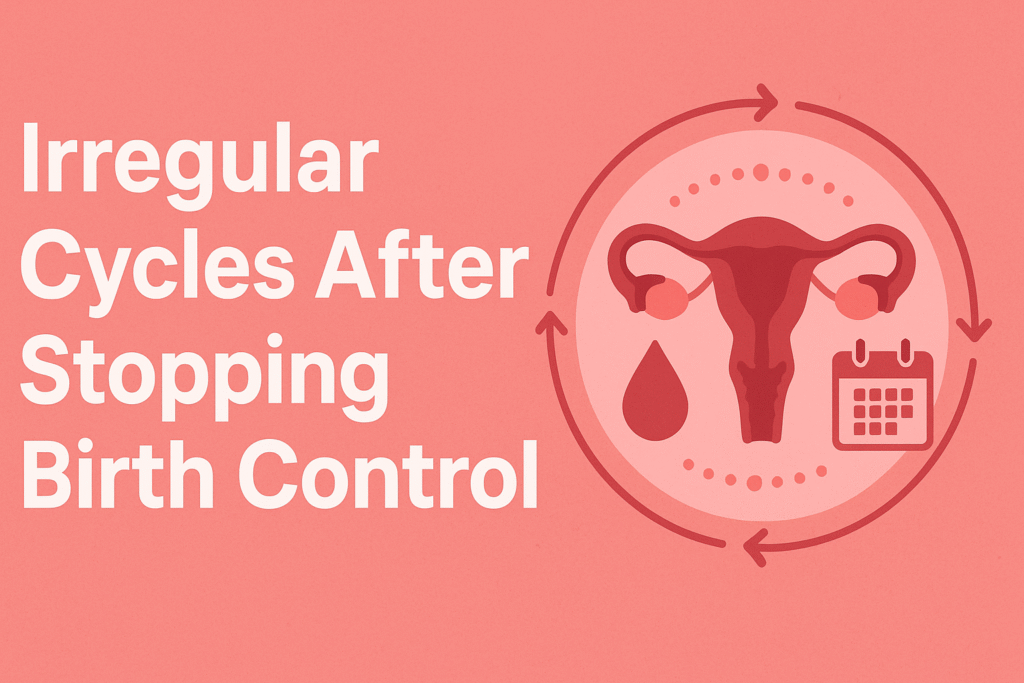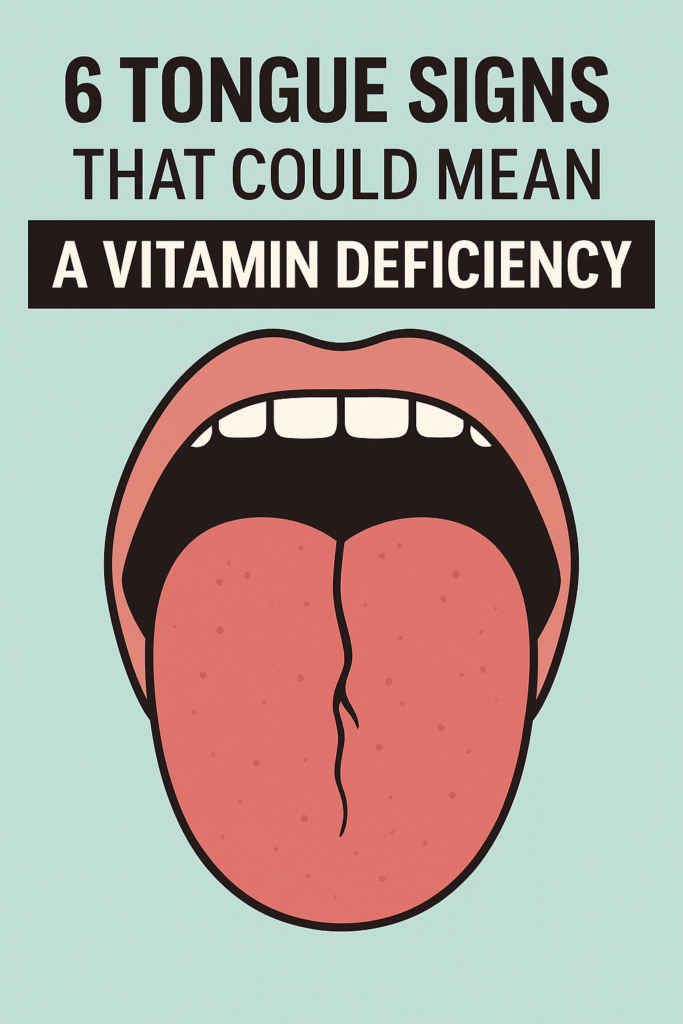
⚠️ Affiliate Disclaimer: This post may contain affiliate links, which means I may earn a small commission — at no extra cost to you — if you make a purchase through one of these links. I only recommend products or services I genuinely trust and believe can provide value. Thank you for supporting My Medical Muse!
Irregular Cycles After Stopping Birth Control: 7 Essential Facts to Know
Irregular Cycles After Stopping Birth Control: What to Expect, Why It Happens, and How to Manage It
Birth control pills and other hormonal contraceptives have long been a reliable option for managing reproductive health. Beyond preventing pregnancy, they are often prescribed to regulate menstrual cycles, reduce painful cramps, improve acne, and ease symptoms of conditions such as endometriosis or polycystic ovary syndrome (PCOS).
When you stop using them, your body begins a process of readjustment. One of the most common outcomes during this transition is a return to irregular menstrual cycles. For some women, periods resume on a predictable schedule within the first month, for others cycles may become inconsistent, with skipped periods, unpredictable bleeding patterns, or new symptoms that weren’t noticeable while on birth control.
This shift can be confusing, even unsettling, especially if you’re trying to conceive or simply want to feel in tune with your body again. The good news is that irregular cycles after stopping hormonal contraceptives are common, usually temporary, and often a sign that your body is recalibrating its natural hormonal rhythm.
In this guide, we’ll explore why these irregularities occur, what changes you might expect, how long it typically takes for cycles to normalize, and practical strategies to support your body during the transition. We’ll also discuss when it’s wise to seek medical advice, particularly if irregularities persist beyond the normal adjustment window.
How Birth Control Affects the Menstrual Cycle
1. The Natural Menstrual Cycle
To understand why your body may respond with irregular cycles after stopping birth control, it helps to first look at how the menstrual cycle works in its natural state.
A typical menstrual cycle lasts anywhere from 21 to 35 days, though 28 days is often used as the “average.” Each cycle is a carefully coordinated sequence of hormonal changes designed to prepare the body for the possibility of pregnancy.
Here’s a breakdown of the key players:
- Follicle-Stimulating Hormone (FSH): Released by the pituitary gland, FSH stimulates the ovaries to develop follicles. Each follicle contains an immature egg.
- Luteinizing Hormone (LH): A surge in LH triggers ovulation, when a mature egg is released from the ovary and made available for fertilization.
- Estrogen: Produced mainly by developing follicles, estrogen thickens the uterine lining (endometrium) and signals the body that it’s approaching ovulation.
- Progesterone: After ovulation, the follicle transforms into the corpus luteum, which produces progesterone. This hormone further prepares the uterine lining to support a fertilized egg.
If no pregnancy occurs, estrogen and progesterone levels drop. This hormonal decline causes the uterine lining to shed, resulting in menstrual bleeding, the start of a new cycle.
This delicate interplay ensures that ovulation and menstruation happen in rhythm, but it’s also highly sensitive to external factors like stress, weight changes, and medical conditions.
2. How Birth Control Intervenes
Hormonal contraceptives including the pill, patch, vaginal ring, hormonal IUDs, and injectables work by deliberately altering this natural cycle to prevent pregnancy. They do so through several mechanisms:
- Suppressing Ovulation:
The steady dose of synthetic estrogen and/or progestin prevents the surge of LH, effectively stopping the release of an egg. Without ovulation, pregnancy cannot occur. - Stabilizing Hormone Levels:
Normally, estrogen and progesterone rise and fall dramatically across the cycle. Birth control flattens these fluctuations, keeping hormone levels stable. This not only prevents ovulation but also reduces the intensity of symptoms like cramps, mood swings, and acne that are tied to hormonal shifts. - Thinning the Uterine Lining:
Progestin in particular keeps the endometrium thin. This makes it less hospitable for implantation should fertilization somehow occur. - Thickening Cervical Mucus:
Many hormonal contraceptives also thicken cervical mucus, creating an additional barrier that makes it harder for sperm to reach an egg.
Because of these changes, the “periods” you experience on the pill (or similar methods) aren’t true periods but rather withdrawal bleeds. These occur when you take placebo pills or pause hormone delivery, causing a temporary dip in hormone levels. The bleeding mimics a natural period but doesn’t reflect ovulation or the full hormonal rhythm of a natural menstrual cycle.
This means that when you stop taking hormonal birth control, your body must essentially reboot its natural cycle, which is why irregularities are so common in the months that follow.
Why Cycles Become Irregular After Stopping
When you stop birth control, your body doesn’t instantly snap back into its natural rhythm. Instead, it needs time to relearn its hormonal patterns and reestablish the communication between your brain, ovaries, and uterus. This transition varies from woman to woman and depends on multiple factors.
The Pill-Free Transition
Coming off hormonal contraceptives sets off a chain reaction:
- Ovarian hormone production resumes: While on birth control, the ovaries are essentially in “sleep mode.” Once you stop, they must start producing estrogen and progesterone again, which can take time to stabilize.
- Ovulation may take time to return: Some women ovulate the very first cycle off the pill, while others may need several months before ovulation becomes consistent without ovulation, cycles may be irregular or absent altogether.
- The uterine lining readjusts on birth control, the endometrium is kept thin. After stopping, fluctuating estrogen and progesterone levels influence how quickly it thickens and sheds, which may lead to lighter, heavier, or erratic bleeding.
In short, your reproductive system is recalibrating, and just like restarting a long-idle engine, it doesn’t always run smoothly at first.
Factors Influencing the Adjustment Period
Not every woman’s body responds the same way. Several factors affect how quickly cycles normalize after discontinuing hormonal contraceptives:
- Type of birth control:
- Oral contraceptive pills, the patch, or vaginal rings generally allow for quicker recovery since hormones leave the body within days.
- Long-acting methods such as Depo-Provera (the shot) may delay cycle return for 6–12 months because the hormone lingers in the body.
- Hormonal IUDs and implants fall somewhere in between, with recovery times varying widely.
- Duration of use:
Women who’ve been on hormonal birth control for many years may experience a longer adjustment period compared to those who used it for a shorter time. - Age:
Fertility naturally declines with age, especially after 35. As a result, women who stop birth control later in life may find that cycles take longer to become regular, or they may notice signs of perimenopause overlapping with the transition. - Underlying conditions:
Birth control often masks conditions like PCOS (polycystic ovary syndrome), thyroid imbalances, or endometriosis. Once you stop, these conditions can resurface and contribute to irregular cycles.
Common Irregularities After Stopping Birth Control
Every woman’s experience is unique. Some return to a predictable rhythm within weeks, while others face several months of irregular patterns. Below are the most common changes you may notice.
Missed Periods (Amenorrhea)
It’s not unusual to go without a period for weeks or even months after quitting hormonal contraceptives. This is called post-pill amenorrhea. In most cases, it’s temporary and resolves as ovulation resumes. However, if you’ve gone more than six months without a period, it’s important to see a healthcare provider to rule out underlying causes.
Short or Long Cycles
Instead of the textbook 28-30 days, you may find that your cycles temporarily shorten or lengthen:
- Short cycles (21-24 days): Often due to a shortened luteal phase (the time between ovulation and your next period).
- Long cycles (35-40+ days): May indicate delayed or absent ovulation during that cycle.
These variations usually settle as hormone levels stabilize.
Heavy or Light Bleeding
The return of natural hormone fluctuations can lead to noticeable changes in bleeding patterns:
- Heavier bleeding: Since birth control often keeps the uterine lining thin, the first few natural cycles may result in heavier periods as the lining grows thicker than before.
- Lighter or spotting-only cycles: This may suggest that ovulation is inconsistent or that the uterine lining is still adjusting. Spotting between periods is also common during the transition phase.
PMS and Hormonal Symptoms
While on hormonal contraceptives, many women experience milder PMS or none at all because hormone levels remain stable. After stopping, the return of natural fluctuations can bring symptoms back, sometimes more intensely than remembered:
- Mood swings and irritability
- Breast tenderness
- Bloating and water retention
- Headaches or migraines
- Acne flare-ups
Though frustrating, these are usually signs that your body is returning to its natural hormonal cycle.
Ovulation Irregularities
Ovulation is the central event of the menstrual cycle, and it may take several months to become consistent after stopping birth control. During this time:
- Some cycles may be anovulatory (no egg released), leading to irregular bleeding.
- Fertility may be unpredictable, which is important to keep in mind if you’re trying to conceive or trying to avoid pregnancy.
- Cycle tracking tools (like basal body temperature, cervical mucus observation, or ovulation predictor kits) can help you understand what’s happening with your body during this transition.
In short, irregular cycles after birth control are common, but the exact pattern, whether it’s missed periods, shorter or longer cycles, heavy bleeding, or hormonal symptoms varies from woman to woman. Most of these changes are temporary and improve as your body reestablishes its natural rhythm.
How Long Does It Take for Cycles to Normalize?
When it comes to the menstrual cycle after stopping birth control, one of the most common questions women ask is: “How long will it take for my period to go back to normal?” The answer varies widely, but there are general timelines to keep in mind.
General Timeline
- 1-3 months:
Many women notice their periods return within this window. Ovulation resumes, and cycles begin to resemble their pre-birth-control rhythm. Light irregularitiesn such as spotting, heavier flow, or shorter/longer cycles are common but often stabilize quickly.
- 3-6 months:
Some women continue to experience irregular bleeding, skipped periods, or unpredictable ovulation. This is still within the “normal” adjustment range, especially if you were on birth control for several years or used a long-acting form.
- 6+ months:
If your period hasn’t returned, or cycles remain consistently erratic after six months, it may suggest an underlying issue such as PCOS, thyroid imbalance, or other hormonal concerns. This is usually the point when doctors recommend evaluation.
If you’re trying to conceive, don’t panic if cycles aren’t regular within the first few months. For most women, fertility returns gradually, and irregularity in the beginning is not necessarily a sign of infertility.
The Role of “Post-Birth Control Syndrome”
Some health practitioners use the term Post-Birth Control Syndrome (PBCS) to describe a temporary cluster of symptoms that can arise within the first 4-6 months after discontinuing hormonal contraceptives.
Reported symptoms include:
- Irregular cycles or missed periods
- Acne breakouts or oily skin
- Hair loss or increased shedding
- Digestive changes (bloating, irregular bowel movements)
- Mood swings or anxiety
While not officially recognized as a medical diagnosis, the concept highlights the reality that many women do experience a “transition phase.” Whether you call it PBCS or simply post-contraceptive adjustment, the key takeaway is that these changes are usually temporary and improve as your hormones stabilize.
Supporting Your Cycle Naturally
The good news is that there are proactive steps you can take to help your body recalibrate more smoothly. Lifestyle, nutrition, and holistic practices play a major role in supporting hormonal balance after stopping birth control.
Nutrition and Lifestyle
Food and daily habits can either support or disrupt hormonal regulation. To give your body the best chance of restoring balance:
- Balanced diet: Focus on whole foods: vegetables, fruits, lean proteins, whole grains, nuts, and seeds. Avoid highly processed foods and excessive sugar, which can disrupt blood sugar and hormones.
- Micronutrients: Certain nutrients are especially important for reproductive health:
- Zinc supports ovulation and immune function.
- Magnesium helps reduce PMS symptoms and supports nervous system balance.
- Vitamin B6 plays a role in progesterone production.
- Omega-3 fatty acids (found in fatty fish, chia, flaxseeds) reduce inflammation and support hormone production.
- Hydration: Staying hydrated can help regulate energy, reduce bloating, and support metabolism.
- Exercise: Regular, moderate movement, walking, yoga, cycling, strength training improves circulation, regulates stress hormones, and supports ovulation. Excessive exercise, however, can delay cycle return, especially if paired with low calorie intake.
Stress Management
Chronic stress raises cortisol, a hormone that directly interferes with reproductive hormones. High cortisol can delay or suppress ovulation, leading to longer or skipped cycles.
Ways to keep stress in check include:
- Yoga or gentle stretching to release tension.
- Mindfulness or meditation for emotional regulation.
- Journaling to process emotions and track daily patterns.
- Quality sleep: Aim for 7-9 hours of restful sleep each night, as poor sleep disrupts both cortisol and reproductive hormones.
Cycle Tracking
Tracking your cycle helps you understand how your body is readjusting and can give valuable insights into whether and when ovulation is happening.
Tools include:
- Period tracking apps to log bleeding days, PMS symptoms, and cycle length.
- Basal body temperature (BBT) charts: A slight temperature rise indicates ovulation.
- Cervical mucus observation: Fertile mucus (clear, stretchy, egg-white-like) signals approaching ovulation.
Cycle tracking is particularly useful if you’re trying to conceive or if you want to better understand irregular patterns during this transition phase.
Herbal & Natural Supports
Some women turn to herbal remedies and natural supports to ease the transition. While results vary, and scientific evidence is mixed, many find them helpful:
- Vitex (Chasteberry): Believed to help balance progesterone and support more regular ovulation.
- Maca root: Traditionally used to support energy, mood, and overall endocrine health.
- Evening primrose oil: Sometimes used to ease PMS and regulate cycles.
Always consult a qualified healthcare provider before starting supplements, especially if you are on other medications or trying to conceive, by combining balanced nutrition, stress management, cycle tracking, and selective natural supports, you can actively encourage your body to return to a healthy, regular rhythm after stopping hormonal birth control.
When to See a Doctor
For most women, irregular cycles after stopping birth control are temporary and not a cause for alarm. Still, there are certain situations where professional medical guidance is important.
When to Seek Medical Advice
- No period after 6 months (amenorrhea): While it can take time for ovulation to return, persistent absence of menstruation may signal an underlying condition.
- Severe pelvic pain or heavy bleeding: Pain that disrupts daily life, or bleeding so heavy that you soak through pads/tampons every 1-2 hours, warrants evaluation.
- Signs of thyroid dysfunction: Fatigue, unexplained weight changes, hair thinning, and temperature sensitivity can point to thyroid imbalance.
- Concerns about fertility: If you’re actively trying to conceive and cycles remain irregular, it may help to get early testing and guidance.
What a Doctor May Check
Your healthcare provider might order blood work and imaging to understand what’s happening hormonally and structurally:
- Hormone testing: FSH, LH, estradiol, and progesterone to assess ovulation patterns.
- Thyroid function tests: To rule out hypothyroidism or hyperthyroidism.
- PCOS evaluation: Through ultrasound and hormone markers.
- Ovarian reserve tests: Such as AMH (anti-Müllerian hormone), especially important if you’re over 35.
Early consultation doesn’t just provide peace of mind, it also helps address any conditions that may have been masked by hormonal birth control.
Fertility and Family Planning After Birth Control
1. How Quickly Can You Get Pregnant?
Fertility typically returns as soon as ovulation resumes. Some women conceive the very first cycle off birth control, while others need a few months before cycles stabilize. In general, fertility outcomes after stopping birth control are comparable to women who never used it.
2. Tracking Fertile Windows
If you’re trying to conceive or avoid pregnancy tracking ovulation can be very helpful. Methods include:
- Basal body temperature (BBT): A slight rise in temperature confirms ovulation has occurred.
- Ovulation predictor kits (OPKs): Detect the LH surge that precedes ovulation.
- Cervical mucus monitoring: Fertile mucus is clear, slippery, and stretchy (similar to raw egg whites).
Using more than one method gives the clearest picture of your fertile window.
3. If Pregnancy Doesn’t Happen Right Away
It’s normal for conception to take time. General guidelines are:
- Women under 35: Try for up to 12 months before seeking fertility evaluation.
- Women over 35: Seek evaluation after 6 months of trying, since age affects egg quantity and quality.
Emotional and Mental Health Considerations
Hormonal contraceptives don’t just influence physical cycles, they also affect mood and emotions. When you stop, the transition can feel like an emotional rollercoaster.
Hormonal Rollercoaster
As estrogen and progesterone levels fluctuate naturally again, mood changes, irritability, or heightened anxiety are common. These can feel especially intense if you’ve been on stable synthetic hormones for years.
Body Image Concerns
The return of natural hormones may bring physical changes such as:
- Weight fluctuations (often due to water retention or appetite changes).
- Acne breakouts as oil production increases.
- Hair changes, including shedding or shifts in texture.
These can affect self-esteem, particularly if you experienced smoother skin or more consistent weight while on birth control.
Coping Strategies
Practical tools to navigate the transition:
- Journaling: Track your symptoms to spot patterns and reduce anxiety around unpredictability.
- Open conversations: Share changes and concerns with your partner to foster understanding and support.
- Community support: Online forums or local women’s health groups can provide reassurance and practical advice.
- Professional support: If mood swings or anxiety significantly impact your daily life, don’t hesitate to seek therapy or counseling.
FAQs About Irregular Cycles After Stopping Birth Control
Is it normal not to get a period for months after stopping the pill?
Yes. Some women experience post-pill amenorrhea, where menstruation doesn’t return right away. If it’s been more than six months, see your doctor for evaluation.
Can stopping birth control cause weight gain?
Not directly. Most weight changes are due to shifts in appetite, metabolism, or fluid balance as hormones regulate naturally.
Will my PMS be worse after quitting?
If you had PMS before starting birth control, symptoms may return sometimes more strongly because your natural hormone fluctuations are no longer suppressed.
Can I use supplements to speed up regulation?
Some women find vitamins and herbs (like Vitex or magnesium) helpful, but results vary. Always consult a healthcare provider before starting supplements, especially if you’re trying to conceive.
Final Thoughts
Irregular cycles after stopping birth control are not only common, they’re often a normal part of the body’s transition back to its natural rhythm. For many women, this phase is temporary, lasting just a few months, though the exact timeline varies.
It’s understandable to feel frustrated or concerned, especially if you’re eager to conceive, or if you simply want the comfort of predictable cycles but remember, irregularity in this stage usually reflects your body’s effort to reestablish hormonal balance not a sign that something is “broken.”
The best approach is one of patience and self-support. Nourish yourself with balanced nutrition, manage stress in ways that work for you, and track your cycle to understand your body’s unique patterns. These small but consistent steps can make the transition smoother and help you feel more in control.
At the same time, stay aware of your health. If your period hasn’t returned after six months, if you experience severe pain or heavy bleeding, or if fertility is a concern, don’t hesitate to seek medical guidance. Professional evaluation can provide reassurance and ensure no underlying issues are overlooked, above all, give yourself grace. Your body is doing important work as it shifts back into its natural cycle, with time, care, and support, most women find their rhythms again and along the way, many discover a deeper understanding of their own hormonal health.
Remember, irregular doesn’t always mean unhealthy, this transition is simply your body finding its balance again.
👩⚕️ Need Personalized Health Advice?
Get expert guidance tailored to your unique health concerns through MuseCare Consult. Our licensed doctors are here to help you understand your symptoms, medications, and lab results—confidentially and affordably.
👉 Book a MuseCare Consult NowOther Related Post You May Like:
- Mid-Cycle Spotting Explained: 10 Key Facts About Ovulation Bleeding
- How Long Before Estrogen Cream Works: 3 Proven Timelines for Vaginal Dryness Relief
- How Common Is Ovulation Pain? 7 Shocking Facts Every Woman Must Know
- Birth Control Pill and Low Libido: 7 Surprising Facts Every Woman Should Know
- 8 Powerful Reasons Why Am I Getting UTIs All the Time Despite Good Hygiene


